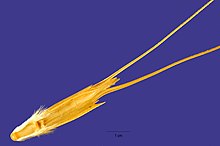| Einkorn wheat | |
|---|---|

| |
| Scientific classification | |
| Kingdom: | Plantae |
| Clade: | Tracheophytes |
| Clade: | Angiosperms |
| Clade: | Monocots |
| Clade: | Commelinids |
| Order: | Poales |
| Family: | Poaceae |
| Subfamily: | Pooideae |
| Genus: | Triticum |
| Species: | T. monococcum
|
| Binomial name | |
| Triticum monococcum | |
| Synonyms | |
|
Triticum monococcum subsp. monococcum | |
| Wild einkorn | |
|---|---|

| |
| Scientific classification | |
| Kingdom: | Plantae |
| Clade: | Tracheophytes |
| Clade: | Angiosperms |
| Clade: | Monocots |
| Clade: | Commelinids |
| Order: | Poales |
| Family: | Poaceae |
| Subfamily: | Pooideae |
| Genus: | Triticum |
| Species: | T. boeoticum
|
| Binomial name | |
| Triticum boeoticum | |
| Synonyms | |
Einkorn wheat (from German Einkorn, literally "single grain") can refer either to a wild species of wheat (Triticum) or to its domesticated form. The wild form is T. boeoticum (syn. T. m. subsp. boeoticum), and the domesticated form is T. monococcum (syn. T. m. subsp. monococcum). Einkorn is a diploid species (2n = 14 chromosomes) of hulled wheat, with tough glumes ('husks') that tightly enclose the grains. The cultivated form is similar to the wild, except that the ear stays intact when ripe[1] and the seeds are larger. The domestic form is known as "petit épeautre" in French, "Einkorn" in German, "einkorn" or "littlespelt" in English, "piccolo farro" in Italian and "escanda menor" in Spanish.[2] The name refers to the fact that each spikelet contains only one grain.
Einkorn wheat was one of the first plants to be domesticated and cultivated. The earliest clear evidence of the domestication of einkorn dates from 10,600 to 9,900 years before present (8650 BCE to 7950 BCE) from Çayönü and Cafer Höyük, two Early Pre-Pottery Neolithic B archaeological sites in southern Turkey.[3] Remnants of einkorn were found with the iceman mummy Ötzi, dated the late 4th millenium BCE.[4]
- ^ Cite error: The named reference
Complex-Originswas invoked but never defined (see the help page). - ^ Le Brun, Alain (1992). "El poblamiento neolítico en la Isla de Chipre: el establecimiento de Khirokitia". Treballs d'Arqueologia (2): 51–67. ISSN 1134-9263. Centre national de la recherche scientifique (França).

- ^ Weiss, Ehud; Zohary, Daniel (October 2011). "The Neolithic Southwest Asian Founder Crops: Their Biology and Archaeobotany". Current Anthropology. 52 (S4): S239–S240. doi:10.1086/658367. S2CID 83924400 – via JSTOR.
- ^ "5,300 Years Ago, Ötzi t'he Iceman Died. Now We Know His Last Meal". Science & Innovation. National Geographic. 2018-07-12. Archived from the original on July 13, 2018. Retrieved 2019-07-31.